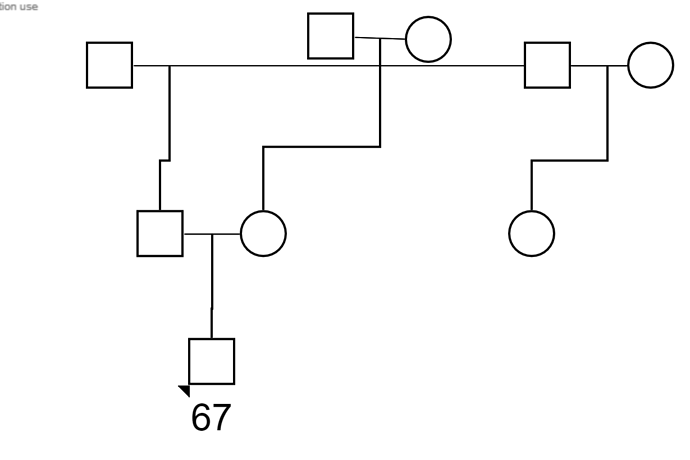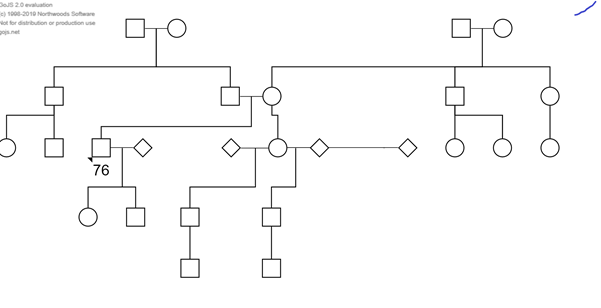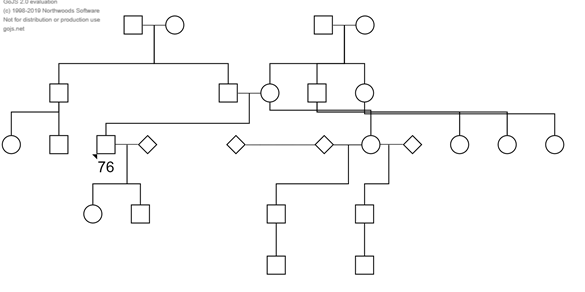Here’s a variation on GenogramLayout that demonstrates having multiple spouses and also supports the ordering of siblings, which is another common request:
<!DOCTYPE html>
<html>
<head>
<meta charset="UTF-8">
<title>Genogram</title>
<meta name="description" content="A genogram is a family tree diagram for visualizing hereditary patterns." />
<meta name="viewport" content="width=device-width, initial-scale=1">
<!-- Copyright 1998-2019 by Northwoods Software Corporation. -->
<script src="go.js"></script>
<script src="AvoidsLinksRouter.js"></script>
<script id="code">
function init() {
var $ = go.GraphObject.make;
myDiagram =
$(go.Diagram, "myDiagramDiv",
{
initialAutoScale: go.Diagram.Uniform,
"undoManager.isEnabled": true,
// when a node is selected, draw a big yellow circle behind it
nodeSelectionAdornmentTemplate:
$(go.Adornment, "Auto",
{ layerName: "Grid" }, // the predefined layer that is behind everything else
$(go.Shape, "Circle", { fill: "yellow", stroke: null }),
$(go.Placeholder)
),
layout: // use a custom layout, defined below
$(GenogramLayout, { direction: 90, layerSpacing: 30, columnSpacing: 10 }),
"LayoutCompleted": function(e) { new AvoidsLinksRouter().avoidOrthogonalOverlaps(e.diagram.links); }
});
// two different node templates, one for each sex,
// named by the category value in the node data object
myDiagram.nodeTemplateMap.add("M", // male
$(go.Node, "Vertical",
{ locationSpot: go.Spot.Center, locationObjectName: "ICON" },
$(go.Panel,
{ name: "ICON" },
$(go.Shape, "Square",
{ width: 40, height: 40, strokeWidth: 2, fill: "lightblue", portId: "" })
),
$(go.TextBlock,
{ textAlign: "center", maxSize: new go.Size(80, NaN) },
new go.Binding("text", "n"))
));
myDiagram.nodeTemplateMap.add("F", // female
$(go.Node, "Vertical",
{ locationSpot: go.Spot.Center, locationObjectName: "ICON" },
$(go.Panel,
{ name: "ICON" },
$(go.Shape, "Circle",
{ width: 40, height: 40, strokeWidth: 2, fill: "pink", portId: "" })
),
$(go.TextBlock,
{ textAlign: "center", maxSize: new go.Size(80, NaN) },
new go.Binding("text", "n"))
));
// the representation of each label node -- nothing shows on a Marriage Link
myDiagram.nodeTemplateMap.add("LinkLabel",
$(go.Node, { selectable: false, width: 1, height: 1, fromEndSegmentLength: 20 }));
myDiagram.linkTemplate = // for parent-child relationships
$(go.Link,
{
routing: go.Link.Orthogonal, curviness: 15,
layerName: "Background", selectable: false,
fromSpot: go.Spot.Bottom, toSpot: go.Spot.Top
},
$(go.Shape, { strokeWidth: 2 })
);
myDiagram.linkTemplateMap.add("Marriage", // for marriage relationships
$(go.Link,
{ selectable: false, routing: go.Link.AvoidsNodes },
$(go.Shape, { strokeWidth: 2, stroke: "blue" })
));
// n: name, s: sex, m: mother, f: father, ux: wife, vir: husband, a: attributes/markers
setupDiagram(myDiagram, [
{ key: 0, n: "Aaron", s: "M", ux: 1, a: ["C", "F", "K"] },
{ key: 1, n: "Alice", s: "F", a: ["B", "H", "K"] },
{ key: 2, n: "Bob", s: "M", ux: 3, a: ["C", "H", "L"], sibling: 2 },
{ key: 3, n: "Barbara", s: "F", m: 1, f: 0, a: ["C"] },
{ key: 4, n: "Bill", s: "M", m: 1, f: 0, ux: 3, a: ["E", "H"], sibling: 3 },
{ key: 10, n: "Ellie", s: "F", m: 3, f: 2, a: ["E", "G"] },
{ key: 11, n: "Dan", s: "M", m: 3, f: 2, a: ["B", "J"] },
{ key: 12, n: "Elizabeth", s: "F", vir: 13, a: ["J"] },
{ key: 13, n: "David", s: "M", m: 4, f: 3, a: ["B", "H"], sibling: 2 },
{ key: 14, n: "Emma", s: "F", m: 4, f: 3, a: ["E", "G"], sibling: 3 }
]);
}
// create and initialize the Diagram.model given an array of node data representing people
function setupDiagram(diagram, array, focusId) {
diagram.model =
go.GraphObject.make(go.GraphLinksModel,
{ // declare support for link label nodes
linkLabelKeysProperty: "labelKeys",
// this property determines which template is used
nodeCategoryProperty: "s",
// if a node data object is copied, copy its data.a Array
copiesArrays: true,
// create all of the nodes for people
nodeDataArray: array
});
setupMarriages(diagram);
setupParents(diagram);
var node = diagram.findNodeForKey(focusId);
if (node !== null) {
diagram.select(node);
// remove any spouse for the person under focus:
//node.linksConnected.each(function(l) {
// if (!l.isLabeledLink) return;
// l.opacity = 0;
// var spouse = l.getOtherNode(node);
// spouse.opacity = 0;
// spouse.pickable = false;
//});
}
}
function findMarriage(diagram, a, b) { // A and B are node keys
var nodeA = diagram.findNodeForKey(a);
var nodeB = diagram.findNodeForKey(b);
if (nodeA !== null && nodeB !== null) {
var it = nodeA.findLinksBetween(nodeB); // in either direction
while (it.next()) {
var link = it.value;
// Link.data.category === "Marriage" means it's a marriage relationship
if (link.data !== null && link.data.category === "Marriage") return link;
}
}
return null;
}
// now process the node data to determine marriages
function setupMarriages(diagram) {
var model = diagram.model;
var nodeDataArray = model.nodeDataArray;
for (var i = 0; i < nodeDataArray.length; i++) {
var data = nodeDataArray[i];
var key = data.key;
var uxs = data.ux;
if (uxs !== undefined) {
if (typeof uxs === "number") uxs = [uxs];
for (var j = 0; j < uxs.length; j++) {
var wife = uxs[j];
if (key === wife) {
// or warn no reflexive marriages
continue;
}
var link = findMarriage(diagram, key, wife);
if (link === null) {
// add a label node for the marriage link
var mlab = { s: "LinkLabel" };
model.addNodeData(mlab);
// add the marriage link itself, also referring to the label node
var mdata = { from: key, to: wife, labelKeys: [mlab.key], category: "Marriage" };
model.addLinkData(mdata);
}
}
}
var virs = data.vir;
if (virs !== undefined) {
if (typeof virs === "number") virs = [virs];
for (var j = 0; j < virs.length; j++) {
var husband = virs[j];
if (key === husband) {
// or warn no reflexive marriages
continue;
}
var link = findMarriage(diagram, key, husband);
if (link === null) {
// add a label node for the marriage link
var mlab = { s: "LinkLabel" };
model.addNodeData(mlab);
// add the marriage link itself, also referring to the label node
var mdata = { from: key, to: husband, labelKeys: [mlab.key], category: "Marriage" };
model.addLinkData(mdata);
}
}
}
}
}
// process parent-child relationships once all marriages are known
function setupParents(diagram) {
var model = diagram.model;
var nodeDataArray = model.nodeDataArray;
for (var i = 0; i < nodeDataArray.length; i++) {
var data = nodeDataArray[i];
var key = data.key;
var mother = data.m;
var father = data.f;
if (mother !== undefined && father !== undefined) {
var link = findMarriage(diagram, mother, father);
if (link === null) {
// or warn no known mother or no known father or no known marriage between them
if (window.console) window.console.log("unknown marriage: " + mother + " & " + father);
continue;
}
var mdata = link.data;
var mlabkey = mdata.labelKeys[0];
var cdata = { from: mlabkey, to: key };
myDiagram.model.addLinkData(cdata);
}
}
}
// A custom layout that shows the two families related to a person's parents
function GenogramLayout() {
go.LayeredDigraphLayout.call(this);
this.initializeOption = go.LayeredDigraphLayout.InitDepthFirstIn;
this.spouseSpacing = 30; // minimum space between spouses
}
go.Diagram.inherit(GenogramLayout, go.LayeredDigraphLayout);
GenogramLayout.prototype.makeNetwork = function(coll) {
// generate LayoutEdges for each parent-child Link
var net = this.createNetwork();
if (coll instanceof go.Diagram) {
this.add(net, coll.nodes, true);
this.add(net, coll.links, true);
} else if (coll instanceof go.Group) {
this.add(net, coll.memberParts, false);
} else if (coll.iterator) {
this.add(net, coll.iterator, false);
}
return net;
};
GenogramLayout.getSiblingNumber = function(v) { // static function as sort comparer
if (v && v.node) {
if (v.node.data && typeof v.node.data.sibling === "number") {
return v.node.data.sibling;
} else if (v.node.isLinkLabel) {
var marrlink = v.node.labeledLink;
if (marrlink && marrlink.fromNode && marrlink.fromNode.data && typeof marrlink.fromNode.data.sibling === "number") {
return marrlink.fromNode.data.sibling;
}
if (marrlink && marrlink.toNode && marrlink.toNode.data && typeof marrlink.toNode.data.sibling === "number") {
return marrlink.toNode.data.sibling;
}
}
}
return 999; // at most a thousand siblings in any family
}
GenogramLayout.getParentIndex = function(v) { // static function for sorting
if (v && v.node) {
var it = v.sourceEdges.iterator;
while (it.next()) {
var e = it.value;
if (e.fromVertex && e.fromVertex.node && e.fromVertex.node.isLinkLabel) {
return e.fromVertex.index;
}
}
}
return -1;
}
GenogramLayout.prototype.initializeIndices = function() {
go.LayeredDigraphLayout.prototype.initializeIndices.call(this);
// accumulate all vertexes for each layer, in order of their .index
var layers = [];
var vertIter = this.network.vertexes.iterator;
while (vertIter.next()) {
var vertex = vertIter.value;
var layer = vertex.layer;
var lay = layers[layer];
if (!lay) { lay = []; layers[layer] = lay; }
lay[vertex.index] = vertex;
}
// iterate over all layers, from the top down, ordering all vertexes in the next layer
for (var l = layers.length-1; l >= 0; l--) {
var lay = layers[l];
if (lay && lay.length > 0) {
lay.sort(function(v, w) {
var vx = GenogramLayout.getSiblingNumber(v);
vx += GenogramLayout.getParentIndex(v) * 1000;
var wx = GenogramLayout.getSiblingNumber(w);
wx += GenogramLayout.getParentIndex(w) * 1000;
if (vx < wx) return -1;
if (vx > wx) return 1;
return 0;
});
for (var i = 0; i < lay.length; i++) {
var v = lay[i];
v.index = i;
}
}
}
}
// disable re-ordering of vertexes in layers for link crossing reductions
GenogramLayout.prototype.reduceCrossings = function() {}
// internal method for creating LayeredDigraphNetwork where husband/wife pairs are represented
// by a single LayeredDigraphVertex corresponding to the label Node on the marriage Link
GenogramLayout.prototype.add = function(net, coll, nonmemberonly) {
var multiSpousePeople = new go.Set();
// consider all Nodes in the given collection
var it = coll.iterator;
while (it.next()) {
var node = it.value;
if (!(node instanceof go.Node)) continue;
if (!node.isLayoutPositioned || !node.isVisible()) continue;
if (nonmemberonly && node.containingGroup !== null) continue;
// if it's an unmarried Node, or if it's a Link Label Node, create a LayoutVertex for it
if (node.isLinkLabel) {
// get marriage Link
var link = node.labeledLink;
var spouseA = link.fromNode;
var spouseB = link.toNode;
// create vertex representing both husband and wife
var vertex = net.addNode(node);
// now define the vertex size to be big enough to hold both spouses
vertex.width = spouseA.actualBounds.width + this.spouseSpacing + spouseB.actualBounds.width;
vertex.height = Math.max(spouseA.actualBounds.height, spouseB.actualBounds.height);
vertex.focus = new go.Point(spouseA.actualBounds.width + this.spouseSpacing / 2, vertex.height / 2);
} else {
// don't add a vertex for any married person!
// instead, code above adds label node for marriage link
// assume a marriage Link has a label Node
var marriages = 0;
node.linksConnected.each(function(l) { if (l.isLabeledLink) marriages++; });
if (marriages === 0) {
var vertex = net.addNode(node);
} else if (marriages > 1) {
multiSpousePeople.add(node);
}
}
}
// now do all Links
it.reset();
while (it.next()) {
var link = it.value;
if (!(link instanceof go.Link)) continue;
if (!link.isLayoutPositioned || !link.isVisible()) continue;
if (nonmemberonly && link.containingGroup !== null) continue;
// if it's a parent-child link, add a LayoutEdge for it
if (!link.isLabeledLink) {
var parent = net.findVertex(link.fromNode); // should be a label node
var child = net.findVertex(link.toNode);
if (child !== null) { // an unmarried child
net.linkVertexes(parent, child, link);
} else { // a married child
link.toNode.linksConnected.each(function(l) {
if (!l.isLabeledLink) return; // if it has no label node, it's a parent-child link
// found the Marriage Link, now get its label Node
var mlab = l.labelNodes.first();
// parent-child link should connect with the label node,
// so the LayoutEdge should connect with the LayoutVertex representing the label node
var mlabvert = net.findVertex(mlab);
if (mlabvert !== null) {
net.linkVertexes(parent, mlabvert, link);
}
});
}
}
}
while (multiSpousePeople.count > 0) {
// find all collections of people that are indirectly married to each other
var node = multiSpousePeople.first();
var cohort = new go.Set();
this.extendCohort(cohort, node);
// then encourage them all to be the same generation by connecting them all with a common vertex
var dummyvert = net.createVertex();
net.addVertex(dummyvert);
var marriages = new go.Set();
cohort.each(function(n) {
n.linksConnected.each(function(l) {
marriages.add(l);
})
});
marriages.each(function(link) {
// find the vertex for the marriage link (i.e. for the label node)
var mlab = link.labelNodes.first()
var v = net.findVertex(mlab);
if (v !== null) {
net.linkVertexes(dummyvert, v, null);
}
});
// done with these people, now see if there are any other multiple-married people
multiSpousePeople.removeAll(cohort);
}
};
// collect all of the people indirectly married with a person
GenogramLayout.prototype.extendCohort = function(coll, node) {
if (coll.has(node)) return;
coll.add(node);
var lay = this;
node.linksConnected.each(function(l) {
if (l.isLabeledLink) { // if it's a marriage link, continue with both spouses
lay.extendCohort(coll, l.fromNode);
lay.extendCohort(coll, l.toNode);
}
});
};
GenogramLayout.prototype.assignLayers = function() {
go.LayeredDigraphLayout.prototype.assignLayers.call(this);
var horiz = this.direction == 0.0 || this.direction == 180.0;
// for every vertex, record the maximum vertex width or height for the vertex's layer
var maxsizes = [];
this.network.vertexes.each(function(v) {
var lay = v.layer;
var max = maxsizes[lay];
if (max === undefined) max = 0;
var sz = (horiz ? v.width : v.height);
if (sz > max) maxsizes[lay] = sz;
});
// now make sure every vertex has the maximum width or height according to which layer it is in,
// and aligned on the left (if horizontal) or the top (if vertical)
this.network.vertexes.each(function(v) {
var lay = v.layer;
var max = maxsizes[lay];
if (horiz) {
v.focus = new go.Point(0, v.height / 2);
v.width = max;
} else {
v.focus = new go.Point(v.width / 2, 0);
v.height = max;
}
});
// from now on, the LayeredDigraphLayout will think that the Node is bigger than it really is
// (other than the ones that are the widest or tallest in their respective layer).
};
GenogramLayout.prototype.commitNodes = function() {
go.LayeredDigraphLayout.prototype.commitNodes.call(this);
// position regular nodes
this.network.vertexes.each(function(v) {
if (v.node !== null && !v.node.isLinkLabel) {
v.node.position = new go.Point(v.x, v.y);
}
});
// position the spouses of each marriage vertex
var layout = this;
this.network.vertexes.each(function(v) {
if (v.node === null) return;
if (!v.node.isLinkLabel) return;
var labnode = v.node;
var lablink = labnode.labeledLink;
// In case the spouses are not actually moved, we need to have the marriage link
// position the label node, because LayoutVertex.commit() was called above on these vertexes.
// Alternatively we could override LayoutVetex.commit to be a no-op for label node vertexes.
lablink.invalidateRoute();
var spouseA = lablink.fromNode;
var spouseB = lablink.toNode;
// prefer fathers on the left, mothers on the right
if (spouseA.data.s === "F") { // sex is female
var temp = spouseA;
spouseA = spouseB;
spouseB = temp;
}
// see if the parents are on the desired sides, to avoid a link crossing
var aParentsNode = layout.findParentsMarriageLabelNode(spouseA);
var bParentsNode = layout.findParentsMarriageLabelNode(spouseB);
if (aParentsNode !== null && bParentsNode !== null && aParentsNode.position.x > bParentsNode.position.x) {
// swap the spouses
var temp = spouseA;
spouseA = spouseB;
spouseB = temp;
}
spouseA.position = new go.Point(v.x, v.y);
spouseB.position = new go.Point(v.x + spouseA.actualBounds.width + layout.spouseSpacing, v.y);
if (spouseA.opacity === 0) {
var pos = new go.Point(v.centerX - spouseA.actualBounds.width / 2, v.y);
spouseA.position = pos;
spouseB.position = pos;
} else if (spouseB.opacity === 0) {
var pos = new go.Point(v.centerX - spouseB.actualBounds.width / 2, v.y);
spouseA.position = pos;
spouseB.position = pos;
}
});
// position only-child nodes to be under the marriage label node
this.network.vertexes.each(function(v) {
if (v.node === null || v.node.linksConnected.count > 1) return;
var mnode = layout.findParentsMarriageLabelNode(v.node);
if (mnode !== null && mnode.linksConnected.count === 1) { // if only one child
var mvert = layout.network.findVertex(mnode);
var newbnds = v.node.actualBounds.copy();
newbnds.x = mvert.centerX - v.node.actualBounds.width / 2;
// see if there's any empty space at the horizontal mid-point in that layer
var overlaps = layout.diagram.findObjectsIn(newbnds, function(x) { return x.part; }, function(p) { return p !== v.node; }, true);
if (overlaps.count === 0) {
v.node.move(newbnds.position);
}
}
});
};
GenogramLayout.prototype.findParentsMarriageLabelNode = function(node) {
var it = node.findNodesInto();
while (it.next()) {
var n = it.value;
if (n.isLinkLabel) return n;
}
return null;
};
// end GenogramLayout class
</script>
</head>
<body onload="init()">
<div id="sample">
<div id="myDiagramDiv" style="border: solid 1px black; width:100%; height:600px"></div>
</div>
</body>
</html>
This produces:







